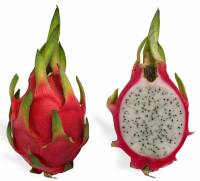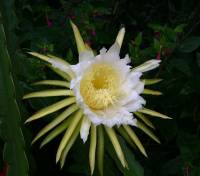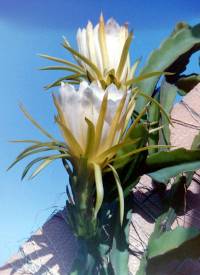Table of Contents
Pitahaya, Dragon Fruit
Botanical Information
| Botanical Information | |
|---|---|
| Order | Caryophyllales |
| Family | Cactaceae |
| Genus | Hylocereus |
| Common Name | Pitahaya, Dragon Fruit |
| Species | H. undatus |
Maturity days
Planting Months
| Planting months | |||||||||||
|---|---|---|---|---|---|---|---|---|---|---|---|
| Jan | Feb | Mar | Apr | May | Jun | Jul | Aug | Sep | Oct | Nov | Dec |
| X | X | X | X | X | X | X | X | X | X | X | X |
Permaculture uses
| Permaculture uses | ||
|---|---|---|
| Usage 1 | Usage 2 | Usage 3 |
| Food_Forest | Fruit | |
Growing condition comments
| Growing Condition | Comment |
|---|---|
| Drought Tolerant | No |
| Humidity tolerant | No |
| Planting area | Ground |
| Sunlight | Full_sun |
Photos
Short comments
Well drained soil, this is a tropical cactus, waterlogged roots will rot. Best grown by cutting to ensure correct cultivar.
Grow on a trelis, and allow to sprawl out at desired height, and this promotes flowering and fruiting. If left to grow up a tree, the cactus will not flower/fruit until it's in the upper storey of the tree.
General comments
It is widely distributed through the tropics in cultivation.
They climb by use of aerial roots and can reach a height 10 meters or more growing on rocks and trees. Dragonfruit stems are climbing, creeping, sprawling or clambering, and branch profusely.
The flowers are nocturnal and only open for one night.
The fruit is oblong to oval, red with large bracteoles, with white pulp and edible black seeds.


